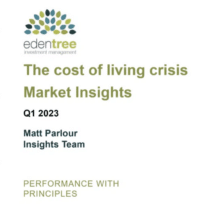2022 has been terrible for investors; 2023 promises to be much better, predicts Glyn Owen, Investment Director, Momentum Global Investment Management.
2022 has been an exceptionally difficult year, with very few assets preserving capital let alone earning a positive real return. Global equities and bonds have suffered steep falls, in the case of bonds one of the worst periods in decades. Despite the over-arching pessimism we see the foundations for a recovery in markets in 2023 and believe the prospects ahead are more promising than for some time. The reasons are several:
1. Inflation, the scourge of 2022, is at or close to a peak, and we expect it to fall materially next year. Central bank policy tightening, particularly in the US, has been steep, interest rates are in restrictive territory, money supply in the US is shrinking month-on-month, an extremely unusual occurrence, and dollar liquidity is very tight. The Fed will tolerate an economic slowdown and increase in unemployment to bring inflation down to its 2% target. Monetary policy takes effect with lags, but its impact on activity and inflation is beyond doubt.
2. Economic activity is already under pressure due to the impact of high inflation on disposable incomes, and rising interest rates on mortgage costs, while businesses are suffering from steep rises in input prices and labour costs. A recession is inevitable in the UK and Europe, which are more exposed to surging energy prices than the US, but even in the US a recession is increasingly likely. Reduced activity will bring supply and demand back into balance and weaken inflation.
3. The end of the post-pandemic boom and the impact of weakening activity levels is already evident in falling commodity markets, notably in European natural gas prices, from the surge following Russia’s invasion of Ukraine, and easing global supply chain pressures, including steep falls in shipping costs. These will flow through to inflation in due course.
4. The Fed is very likely to downshift the pace of tightening before pausing and peaking some time in the first half of 2023. While there is considerable uncertainty around the duration of restrictive policy, there is less uncertainty around the peak, and we are very confident that most of the Fed’s tightening, and its steepest part, is behind us. This could well result in the dollar’s strength also peaking, resulting in a significant easing of financial conditions globally. That is critical for markets.
5. The world’s second largest economy, and the driver of global growth for much of the past 20 years, China, has had a torrid year. The crackdown on China’s digital economy, the deleveraging of its huge property development industry, the zero-Covid policy and weakening global growth, have resulted in the slowest growth rate in China since the 1970s and dramatic falls in the stock market, culminating in a huge selloff in October following the 20th National Congress and President Xi’s consolidation of power. Since then there have been some positive developments, with increasing assistance for the property sector and an easing of Covid restrictions, and more is likely to follow. China is set for a significant recovery next year, albeit well below earlier levels of growth. From peak to trough the Chinese stock market fell by over 60% and now offers substantial upside.
6. Falls in markets elsewhere have been less precipitous but nevertheless substantial and have improved valuations materially. From historic lows in 2021 of near zero or below in some cases, government bond yields have moved up sharply and now offer good diversification benefits, while equities have gone a long way to discounting much of the uncertainties and consequences of the looming slowdown. While corporate profits face headwinds and there are likely to be some disappointments ahead, the longer-term recovery and upside potential is significant.
7. Risks and uncertainty have been in abundance, and there remains much to worry about, but most of those risks are now in better balance. The war in Ukraine has been a disaster in every respect but the worst fears during the initial stages are now much diminished. 2023 is set to be a difficult year for the global economy but most of the developed world enters that tough period with households, corporates and banks in good shape, with generally strong balance sheets. There will no doubt be some casualties ahead, especially if, as is quite possible, central banks risk overkill with policy, but the risks are not systemic. In many cases those casualties, while painful for some, are a healthy longer-term development, removing the excesses of the boom such as crypto markets, Chinese property, zombie companies and vastly over-valued assets such as UK gilts and other safe-haven bonds.
8. Investor sentiment in recent weeks became extremely negative, as evidenced by the sharp rallies on the first sign of some positive developments. This is invariably a signal of unusually good buying opportunities.
9. We might not yet be at the point of maximum risk aversion, and the uncertainties are considerable around further policy tightening required to bring inflation sustainably to target levels of 2%, the damage inflicted on economic activity to reach that goal and the unintended consequences of aggressive central bank tightening, but we are a long way through the monetary cycle in the US and the substantial falls in nearly all asset classes in 2022 provide some excellent opportunities for investors in 2023, when we expect monetary policy to turn and recovery to begin.

































